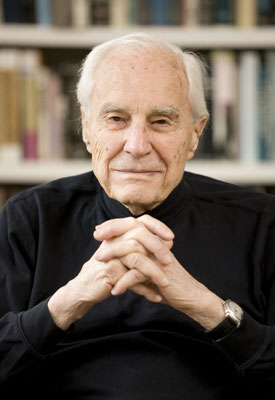by Pat McSparin // Spring 2011

In the library at Diastole, E. Grey Dimond, M.D., sits in a chair that was a gift from his late wife. The teak chair’s hand-carved details bear witness to a craftsman rendering absolute focus and unwavering commitment into creating something both strong and beautiful. For dedicating that same brand of care and commitment to UMKC for more than 40 years, Dimond is being honored with the 2011 Chancellor’s Medal.
Provost Emeritus for Health Sciences, Dimond is the founder of UMKC’s School of Medicine. According to Dimond, city leaders Nathan Stark and Homer Wadsworth proposed to Kansas City Mayor H. Roe Bartle in 1962 that the university take over what was then General Hospital. Bartle agreed and later told Dimond that he laughed all day at the offer thinking he had gotten rid of the place.
As their plan moved forward, Stark and Wadsworth convinced Dimond and his wife, Mary, to join them. UMKC’s School of Medicine opened in the fall of 1970 and has since graduated more than 3,000 doctors. But Dimond did more than help establish the Medical School. He also developed the school’s six-year B.A./M.D. program, which revolutionized the way medical schools educate doctors. Dimond first had the idea when he was a professor at University of Kansas before coming to UMKC.
“I was on the search and admissions committees for recruiting kids,” he said, “and I was also a professor, so I was both selecting students and teaching students. At that time, everyone went to college for four years and to medical school for four years. As I watched, I saw that we were too late. I saw that these were serious kids and four years of college slowed many of them down. They were being wasted to a great extent. I gradually formed my idea: Why not get them into medical school and liberal arts at the same time?”
A proud and defiant look comes to Dimond’s face as he talks about the development of the six-year program. An idea as revolutionary as that didn’t come together without pushback. Dimond and his colleagues overcame resistance from all sides, including the medical community and colleges and universities across the country.
“It’s hard for families to send a kid to college and then to medical school for four years.”
–E. Grey Dimond
“The barrier to doing this was so many liberal arts schools in this country make their living off of pre-med students,” he said. “It’s hard for families to send a kid to college and then to medical school for four years. The economics of the U.S. makes the six-year program much more attractive. But even in Missouri—just think about the good liberal arts schools—all of them resented what we were doing.”
Today, several medical schools have added a version of the six-year program, but many encountered similar obstacles along the way. “Harvard has twice tried to implement a similar program,” Dimond said. “The College of Arts and Sciences at Harvard resented this thing where you could enter medical school and at the same time pick up liberal arts credits. They had to stop. But they came back again, and now they have a variety of what we’re doing.”
Dimond’s impact is visible everywhere in UMKC’s School of Medicine. The E. Grey Dimond, M.D., Program in International Medicine gives students the opportunity to develop an understanding of patient cultures and traditions in foreign countries and to gain international experience. The E. Grey Dimond, M.D., Take Wing Award honors a graduate who has excelled in medicine, academic medicine, research or community service. Take Wing is a bronze sculpture cast from a carving Dimond created in 1952 from a piece of driftwood. The sculpture stands in front of the School of Medicine.
The most visible of Dimond’s legacy is the Mary Clark and E. Grey Dimond Scholars’ Center, better known as Diastole. Dimond and his wife established Diastole as a peaceful and inspirational gathering place available for UMKC retreats, recitals, meetings, reunions and other university gatherings. The tranquil compound is named for the interim between heartbeats when the heart muscle is at rest.
Dimond sits in the hand-carved chair in Diastole. Volumes of books about everything from history to poetry to medicine surround him. But on Hospital Hill, he is also encircled by the medical school borne and shaped by his focus, determination and commitment.
